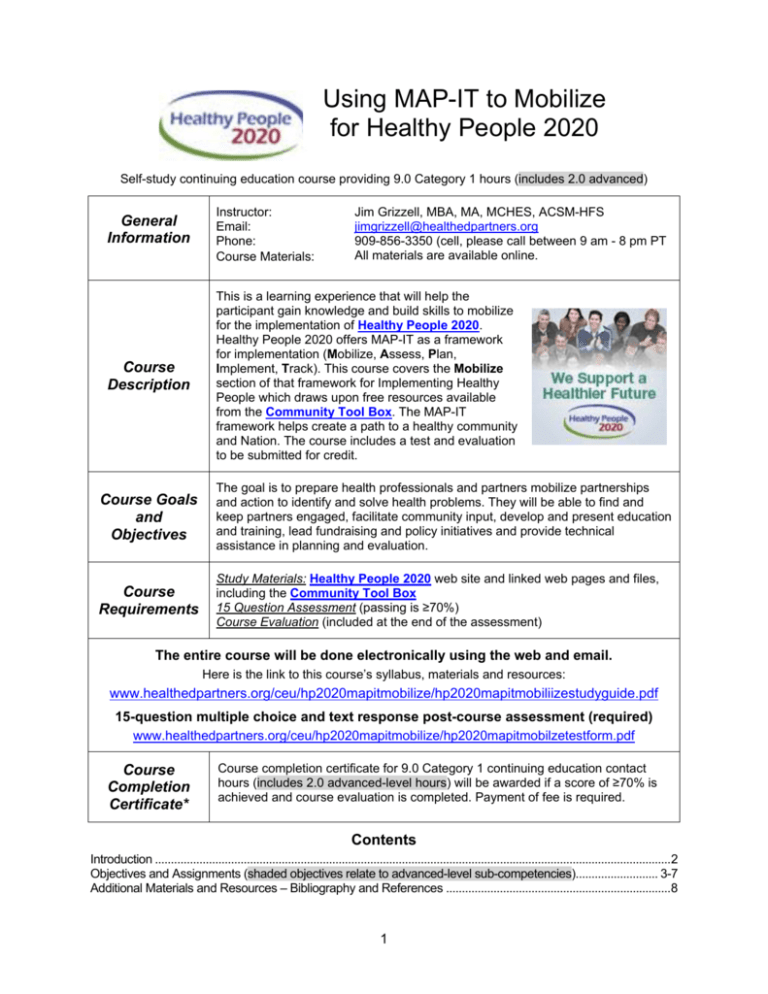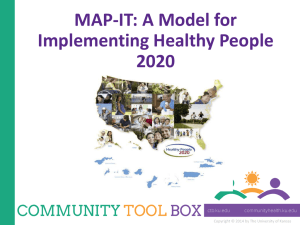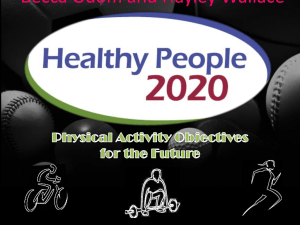Study Guide - Health Education Partners
advertisement

Using MAP-IT to Mobilize for Healthy People 2020 Self-study continuing education course providing 9.0 Category 1 hours (includes 2.0 advanced) General Information Instructor: Email: Phone: Course Materials: Jim Grizzell, MBA, MA, MCHES, ACSM-HFS jimgrizzell@healthedpartners.org 909-856-3350 (cell, please call between 9 am - 8 pm PT All materials are available online. Course Description This is a learning experience that will help the participant gain knowledge and build skills to mobilize for the implementation of Healthy People 2020. Healthy People 2020 offers MAP-IT as a framework for implementation (Mobilize, Assess, Plan, Implement, Track). This course covers the Mobilize section of that framework for Implementing Healthy People which draws upon free resources available from the Community Tool Box. The MAP-IT framework helps create a path to a healthy community and Nation. The course includes a test and evaluation to be submitted for credit. Course Goals and Objectives The goal is to prepare health professionals and partners mobilize partnerships and action to identify and solve health problems. They will be able to find and keep partners engaged, facilitate community input, develop and present education and training, lead fundraising and policy initiatives and provide technical assistance in planning and evaluation. Course Requirements Study Materials: Healthy People 2020 web site and linked web pages and files, including the Community Tool Box 15 Question Assessment (passing is ≥70%) Course Evaluation (included at the end of the assessment) The entire course will be done electronically using the web and email. Here is the link to this course’s syllabus, materials and resources: www.healthedpartners.org/ceu/hp2020mapitmobilize/hp2020mapitmobiliizestudyguide.pdf 15-question multiple choice and text response post-course assessment (required) www.healthedpartners.org/ceu/hp2020mapitmobilize/hp2020mapitmobilzetestform.pdf Course Completion Certificate* Course completion certificate for 9.0 Category 1 continuing education contact hours (includes 2.0 advanced-level hours) will be awarded if a score of ≥70% is achieved and course evaluation is completed. Payment of fee is required. Contents Introduction ...................................................................................................................................................................2 Objectives and Assignments (shaded objectives relate to advanced-level sub-competencies).......................... 3-7 Additional Materials and Resources – Bibliography and References .......................................................................8 1 Getting Started: Mobilize for Implementing Healthy People The goal of this course is to help health professionals and people in agencies and organizations use the mobilize component of Healthy People 2020 and MAP-IT to implement Healthy People 2020. They will be able be effective users and expert consultants to find and explain tools and resources available on the Healthy People 2020 and The Community Tool Box (CTB) web sites to achieve the Nation’s health goals and objectives. They will have a very solid understanding of how to implement Healthy People 2020. The course covers the Mobilize section of Program Planning. All of the materials to study and read are at these Healthy People 2020 web site links: www.healthypeople.gov and www.healthypeople.gov/2020/tools-and-resources/Program-Planning These are the graphics you will see and can click on to reach the pages. Throughout the “Study Guide” each study assignment can be opened from the electronic version / pdf file or from the Healthy People 2020 and the Community Toolbox web pages. You will be asked to read each page and click on and read text from links on those pages. In all there are hundreds of pages of information, resources and tools beyond the original pages you will be asked to read and review. The test has both multiple choice and short answer questions. Since there are more components to understanding how to mobilize than this hour course can cover you are not required to read every page. You will have the opportunity to select what you feel is most relevant to you. Be prepared to very briefly and concisely (≤50 words) describe why the component you selected was important to you. Opening the Study Assignments and Time Estimates 1. Keep this Study Guide opened on your computer to be able to click on the links in the Study Guide. 2. Follow instructions on a printed copy to get to assignments. Time to complete the course includes two components. 1) Estimated time to read text based on reading speeds of 250 words per minute (wpm) to faster speed at 300 wpm. 2 Estimated Time Objectives and Assignments ~0.5 hours Introduction Review this Study Guide (~30 min, shaded objectives relate to Master Certified Health Education Specialist advanced-level sub-competencies) ~0.5 hours Orientation to “Program Planning” NOTE: this assignment is identical in each of the 6 MAP-IT Courses http://www.healthypeople.gov/2020/tools-and-resources/program-planning/ After studying the materials the participant will be able to: 1. List the contents of the Implementing Healthy People 2020 page 2. Define framework for implementation: MAP-IT 3. List Planning Resources to help plan interventions 4. Describe the how to make the case and resources for funding and obtain program support 5. Provide expert assistance on planning and resources Study Assignments Program Planning - read text on main/center portion of the page (<5 min, do not read text from Mobilize, Assess, Plan, Implement or Track at this time) Share Your Story - click on and review how you will be able to share what your organization has done to improve the health of your community. (~10 min, www.healthypeople.gov/2020/healthy-people-in-action/stories-from-thefield/Share-Your-Story) o Click on this link to see steps 2 and 3 www.healthedpartners.org/ceu/hp2020mapitmobilize/shareyourstorysteps2 and3.pdf Stories from the Field – click on the heading on the left. Select, explore and read a “story” related to your interests – try one of these: click on a green or blue pin, scroll down the page to stories or filter by topic area and LHI. Click on (<10 min, https://www.healthypeople.gov/2020/healthy-people-in-action/Storiesfrom-the-Field). o Here is an example: https://www.healthypeople.gov/2020/healthy-people-inaction/story/healthy-people-2020-work-community-green-cleaningworkshops ~0.25 hours Orientation to Mobilizing http://www.healthypeople.gov/2020/tools-and-resources/program-planning/Mobilize After studying the materials the participant will be able to: 1. Describe steps to mobilize for identifying and solving health problems 2. Identify stakeholders/partners and questions to consider for organizing a coalition Study Assignments for Mobilize Page Mobilize Web Page - read the text on the page Brainstorm: Potential Partners – from the right side of the page click on to open and read the pdf file (<5 min) 3 Organizing a Coalition - click on to open and read the pdf file (<5 min) ~1.5 hours Orientation to Community Tool Box and MAP-IT NOTE: this assignment is identical in each of the 6 MAP-IT Courses After studying the materials the participant will be able to: 1. Describe The Community Toolbox, and provide expert assistance on a model of practice as a planning model; and core principles, assumptions, and values to guide the work Study Assignments for Community Tool Box and MAP-IT The Community Toolbox – read text on the CTB home page (http://ctb.ku.edu/en/default.aspx) (~ 5 min, for purposes of this course you do not need to click on and read links pages) Chapter 1: Our Model for Community Change and Improvement http://ctb.ku.edu/en/tablecontents/chapter_1001.htm o Section 1. A Community Tool Box Overview and Gateway to the Tools – (http://ctb.ku.edu/en/tablecontents/chapter_1001.htm) read the Main Section, Examples, Related Topics (titles only), Tools & Checklist, PowerPoint (~25 min, read text on the section’s pages only, for purposes of this course you do not need to read text on linked pages) o Section 3. Our Model of Practice: Building Capacity for Community and System Change – read the Main Section, Examples, Related Topics (titles only), Tools & Checklists, PowerPoint (~35 minutes) o Section 6. Core Principles, Assumption, and Values to Guide the Work - read the Main Section, Examples, Related Topics (titles only), Tools & Checklists, PowerPoint (~30 minutes) ~0.75 hours MAP-IT: Mobilize – Chapter 1. Our Model for Community Change and Improvement - Framework and Lessons Learned http://ctb.ku.edu/en/tablecontents/chapter_1001.htm After studying the materials the participant will be able to: 1. Select planning model(s) for programs 2. Explain key factors for community and systems change 3. Describe how community partnerships, support organizations and grantmakers can work together effectively 4. Differentiate types of communities that organize 5. Define community organization Study Assignments for Chapter 1 Section 7. Working together for Healthier Communities: A Framework for Collaboration Among Community Partnerships, Support Organizations, and Funders – read the Main Section, Examples, Related Topics (titles only), Tools & Checklist, PowerPoint (~15 min, read text on the section’s pages only, for purposes of this course you do not need to read text on linked pages) Section 8. Lessons Learned on Community Organization and Change – read the Main Section, Examples, Related Topics (titles only), Tools & Checklists, PowerPoint (~30 minutes) ~1.0 hours MAP-IT: Mobilize – Chapter 4. Getting Issues on the Public Agenda 4 http://ctb.ku.edu/en/tablecontents/chapter_1004.htm After studying the materials the participant will be able to: 1. Define “local agenda” 2. List steps to get issues into the minds of the public 3. Describe some conditions that enable getting community health and development issues on the local agenda Study Assignments for Chapter 4 Section 1. Developing a Plan for Getting Community Health and Development Issues on the Local Agenda – read the Main Section, Examples, Related Topics (titles only), Tools & Checklist, PowerPoint (~30 min, read text on the section’s pages only, for purposes of this course you do not need to read text on linked pages) Section 2, 3, 4 or 5. – select one of these sections and read the Main Section, Examples, Related Topics (titles only), Tools & Checklists, PowerPoint (~30 minutes, be prepared to state the name of the section your read and briefly (≤50 words) describe the content of the section in the course’s test) ~1.25 hours MAP-IT: Mobilizing – Chapter 5. Choosing Strategies to Promote Community Health and Development http://ctb.ku.edu/en/tablecontents/chapter_1010.htm After studying the material in this section the participant will be able to: 1. Explain the meaning of organizing for change 2. Describe why people should engage in community organization 3. List effective strategies in community organization Study Assignments Section 1. Strategies for Community Change and Improvement: An Overview – read the Main Section, Examples, Related Topics (titles only), Tools & Checklist, PowerPoint (~30 min, read text on the section’s pages only, for purposes of this course you do not need to read text on linked pages) Section 2, 3, 4, 5 or 6. – select one of these sections and read the Main Section, Examples, Related Topics (titles only), Tools & Checklists, PowerPoint (~40 minutes, be prepared to state the name of the section your read and briefly (≤50 words) describe the content of the section in the course’s test) ~0.75 hours MAP-IT: Mobilizing – Chapter 7. Encouraging Involvement in Community Work http://ctb.ku.edu/en/tablecontents/chapter_1006.htm After studying the material in this section the participant will be able to: 1. Discuss planning as a way to organize action to lead to fulfillment of goals 2. Explain why people should develop a plan 3. Explain how to develop a plan 4. Promote participation by, contact and involve influential people and people affected by a problem Study Assignments for Chapter 7 Section 1. Developing a Plan for increasing Participation in Community Action – read the Main Section, Examples, Related Topics (titles only), Tools & 5 Checklist, PowerPoint (~15 min, read text on the section’s pages only, for purposes of this course you do not need to read text on linked pages) Section 2, 3, 4, 5, 6 or 7. – select one of these sections and read the Main Section, Examples, Related Topics (titles only), Tools & Checklists, PowerPoint (~20 minutes, be prepared to state the name of the section your read and briefly (≤50 words) describe the content of the section in the course’s test) ~0.75 hours MAP-IT: Mobilizing – Chapter 16. Group Facilitation and Problem Solving http://ctb.ku.edu/en/tablecontents/chapter_1016.htm After studying the material in this section the participant will be able to: 1. Explain what effective meetings accomplish 2. Facilitate and promote cooperation and collaboration among stakeholders responsible for programs 3. Describe the four phases of a meeting 4. Elicit, facilitate, capture what people say and lead discussions Study Assignments from Chapter 16 Section 1. Conducting Effective Meetings – read the Main Section, Examples, Related Topics (titles only), Tools & Checklist, PowerPoint (~15 min, read text on the section’s pages only, for purposes of this course you do not need to read text on linked pages) Section 2, 3 or 4. – select one of these sections and read the Main Section, Examples, Related Topics (titles only), Tools & Checklists, PowerPoint (~25 minutes, be prepared to state the name of the section your read and briefly (≤50 words) describe the content of the section in the course’s test) ~0.75 hours MAP-IT: Mobilizing – Chapter 23. Modifying Access, Barriers, and Opportunities http://ctb.ku.edu/en/tablecontents/chapter_1023.htm After studying the material in this section the participant will be able to: Describe how to extend opportunities to the poor, increase access for people with physical disabilities or use outreach to increase access Study Assignments from Chapter 23 Section 4, 5 or 6. – select one of these sections and read the Main Section, Examples, Related Topics (titles only), Tools & Checklists, PowerPoint (~40 minutes, be prepared to state the name of the section your read and briefly (≤50 words) describe the content of the section in the course’s test) ~0.75 hours MAP-IT: Mobilizing – Chapter 27. Cultural Competence in a Multicultural World http://ctb.ku.edu/en/tablecontents/chapter_1027.htm After studying the material in this section the participant will be able to: 1. Define culture 2. Explain the importance of understanding culture 3. List principles that help create a favorable environment for building diverse communities Study Assignments from Chapter 27 Section 1. Understanding Culture and Diversity in Building Communities – read the Main Section, Examples, Related Topics (titles only), Tools & Checklist, 6 PowerPoint (~15 min, read text on the section’s pages only, for purposes of this course you do not need to read text on linked pages) Section 2, 3, 4, 5, 6, 7, 8, 9, 10 or 11. – select one of these sections and read the Main Section, Examples, Related Topics (titles only), Tools & Checklists, PowerPoint (~25 minutes, be prepared to state the name of the section your read and briefly (≤50 words) describe the content of the section in the course’s test) ~0.5 hour Take test and answer evaluation questions (pdf form) www.healthedpartners.org/ceu/hp2020mapitmobilize/hp2020mapitmobilzetestform.pdf Before or after immediately after taking the test be sure to save the test pdf file/form to a directory or folder on your computer. Remember where it is. Do this for two reasons: 1) for your records and 2) depending on your email program you may need to send the file as an attachment. If you use something like gmail, aol, yahoo not in conjunction with Microsoft Office Outlook you need need to save the file to attached. Using MS Outlook allows you to click on a submit button to send the answers. Either way is acceptable Be sure to use Adobe Reader XI which allows you to see your answers, see the calculated score on one of the last pages of the test, and go back and change answers. Get Adobe Reader XI for PCs and Macs at these links: http://www.adobe.com/products/reader.html The link should determine and indicate in text of the page which “system” you’re using after you click the “Download now” button. 7 Additional Optional Course Materials and Resources Bibliography and References Green, L., Fielding, J. The u.s. healthy people initiative: its genesis and its sustainability. (draft). Annual Review of Public Health. To be published March 2011. Draft available at: www.csupomona.edu/~jvgrizzell/healthypeople/greenfieldinggenesishistoryhealthypeopleinitiative.pdf Phase II Healthy People 2020 Advisory Committee Webinar/Calls and Meetings This link has all the agendas, slide presentations, reports for meetings since February 2009. http://www.csupomona.edu/~jvgrizzell/hc2020/hp2020accallsmeeting.htm As an example the following shows the files available for the April 2010 meeting. April 2010 Agenda (pdf) Meeting Slides (15 slides, pdf) Webinar (view and listen to the 2 hour meeting call online) Healthy People's Connection to Health Reform o Health Promotion Opportunities from Health Reform (4 pages, pdf) o HR3590 Title IV (9 pages, pdf) How HHS can Shape Healthy People to Prompt Action on Social and Environmental Determinants of Health (5 pages, pdf) Recommendations for Priority Setting (8 pages .pdf) Recommendations from Subcommittee on Strategic Communications on Communication and Implementation of HP2020 (1 page, pdf) Communicating about HP2020 with Key Audiences (4 page table, pdf) HP2010 User Assessment o Use Study One-page Summary (pdf) o User Study Presentation (14 slides, pdf) Healthy People 2020 Webinar Sponsored by IDWellness and HP Career Net on Oct 2, 2009 Webinar o http://vimeo.com/6886306 PowerPoint Slides o www.healthedpartners.org/hc2020/hp2020webinarwnotes.pdf 8





